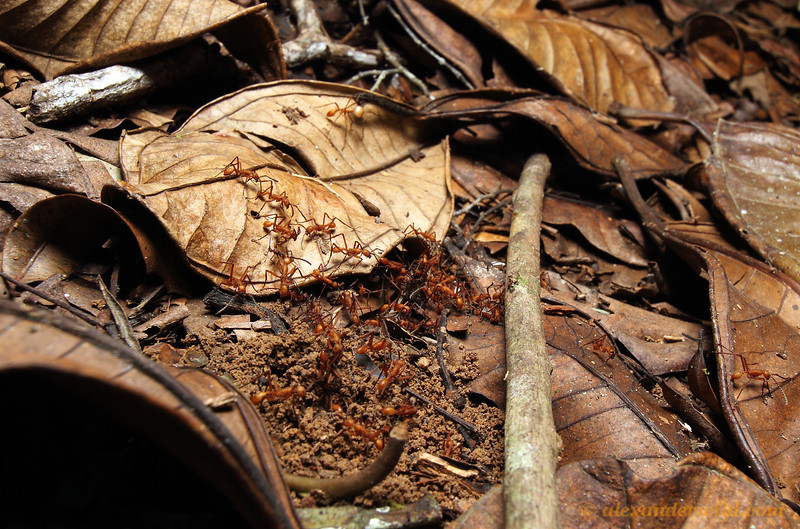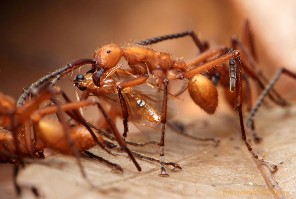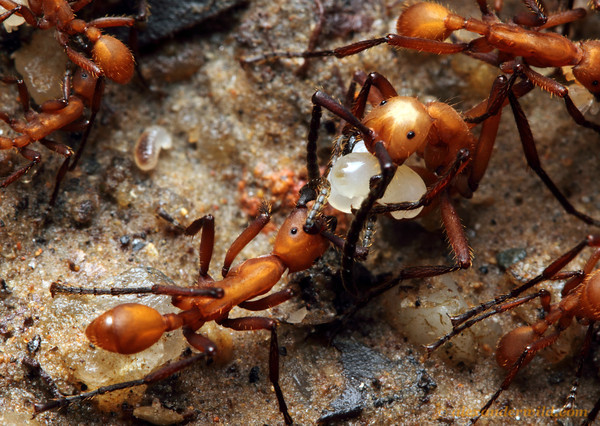Nutrition
How does it get its food?
 Eciton hamatum is a foraging/raiding insect, which uses
vast numbers of insects from the colony to swarm prey. E.
hamatum uses a column raiding style which means that foraging
workers leave the bivouac, where they live, in a three main columns
that specialize in seeking out other insect colonies up to 350 meters away. Another
way that ants meet their nutritional requirements is from other ants in the colony that
have already fed, this is called trophallaxis. Hungry ants will beg or lightly tap on the head of
another ant to “ask” for food. This will trigger the fed ant to
regurgitate some its own food from its stomach to feed the hungry
ant. Check out a video of some army ants in action foraging the
forest for food on Animal Plant
here.
Eciton hamatum is a foraging/raiding insect, which uses
vast numbers of insects from the colony to swarm prey. E.
hamatum uses a column raiding style which means that foraging
workers leave the bivouac, where they live, in a three main columns
that specialize in seeking out other insect colonies up to 350 meters away. Another
way that ants meet their nutritional requirements is from other ants in the colony that
have already fed, this is called trophallaxis. Hungry ants will beg or lightly tap on the head of
another ant to “ask” for food. This will trigger the fed ant to
regurgitate some its own food from its stomach to feed the hungry
ant. Check out a video of some army ants in action foraging the
forest for food on Animal Plant
here.
What does it eat?
 Army ants are carnivorous preying upon many different types
of animals including members of the Mollusca, Annelida,Arachnida,
Crustacea, Chilopoda, Diplopoda, Insecta, and members of multiple
other phylums. However, the group of organisms that the insects feed
on depends on the area in which the ants reside. The ant species
E. hamatum targets in the immature stage of wasps and
nonecitonine ants but occasionally attacks adults as well. These
ants also target treehoppers and multiple other social wasp species.
Army ants are very opportunistic and will take other organisms as
well if the opportunity arises since they are foragers. Their main
diet is mostly due to the animals available to consumption in their
area of foraging.
Army ants are carnivorous preying upon many different types
of animals including members of the Mollusca, Annelida,Arachnida,
Crustacea, Chilopoda, Diplopoda, Insecta, and members of multiple
other phylums. However, the group of organisms that the insects feed
on depends on the area in which the ants reside. The ant species
E. hamatum targets in the immature stage of wasps and
nonecitonine ants but occasionally attacks adults as well. These
ants also target treehoppers and multiple other social wasp species.
Army ants are very opportunistic and will take other organisms as
well if the opportunity arises since they are foragers. Their main
diet is mostly due to the animals available to consumption in their
area of foraging.
Digestive System
When the food that the ant eats is taken in it gets passed through
to the food pouch in the abdomen, the most rear portion of the ant.
From here the food moves from the crop to the actual stomach to be
digested and the nutrients absorbed into its circulatory system, the
waste is then excreted out the
rectum. Click here to see a diagram of the
inside of the ant.
Circulatory System
The circulatory system in ants pumps the haemolymph using a dorsal
vessel to flow from the head to the back of the insect. The
haemolymph delivers nutrients and takes up waste products to be
excreted. After, the haemolymph flows back to the head and is
emptied out into vessel near the brain where the process starts
again.
Circulatory Fluid
 Ants’
circulatory system is responsible for the distribution of nutrients
throughout the ant’s body. Unlike most mammals’ circulatory system,
an ant’s circulatory system is not responsible for transporting
oxygen throughout the body only nutrients, hormones, and cellular
components involved with immune responses. For this reason the fluid
in the circulatory system is not referred to as blood but rather
haemolymph. The ants, as well as many other insects, feed mostly on
the hemolymph from captured prey items.
Ants’
circulatory system is responsible for the distribution of nutrients
throughout the ant’s body. Unlike most mammals’ circulatory system,
an ant’s circulatory system is not responsible for transporting
oxygen throughout the body only nutrients, hormones, and cellular
components involved with immune responses. For this reason the fluid
in the circulatory system is not referred to as blood but rather
haemolymph. The ants, as well as many other insects, feed mostly on
the hemolymph from captured prey items.
Respiratory System
Ants respire by letting air into their bodies
through openings on the outside of body called spiracles. These
spiracles, that let air through the exoskeleton, are connected to
tracheal tubes that run throughout the body of the insect and
provide the body with oxygen.
Back to
Home
Continue on to
Reproduction